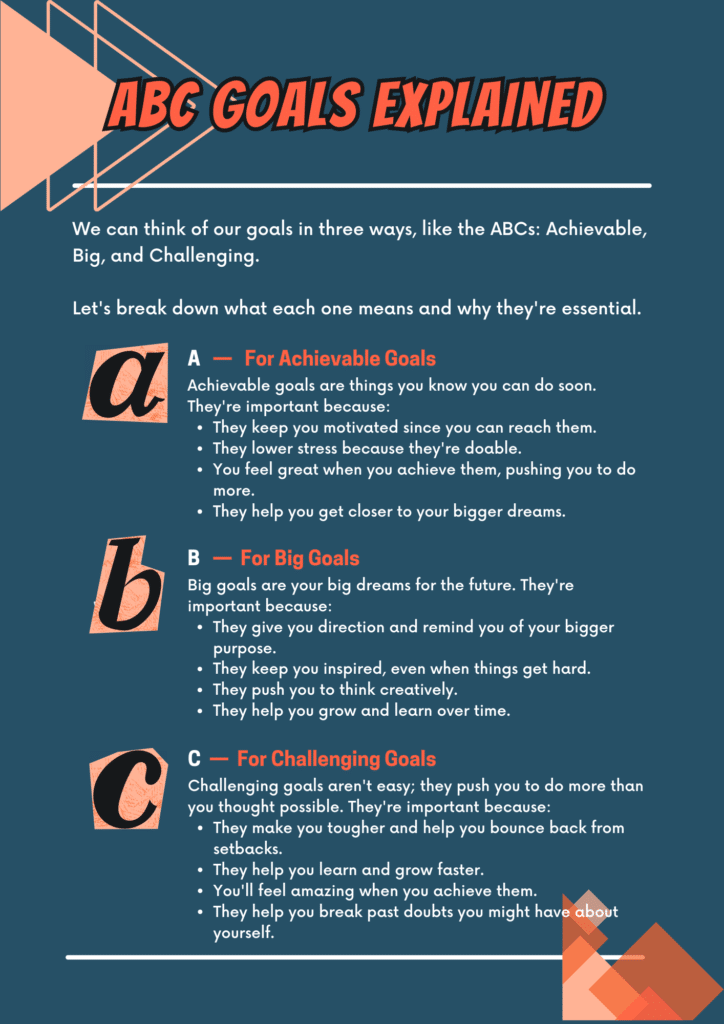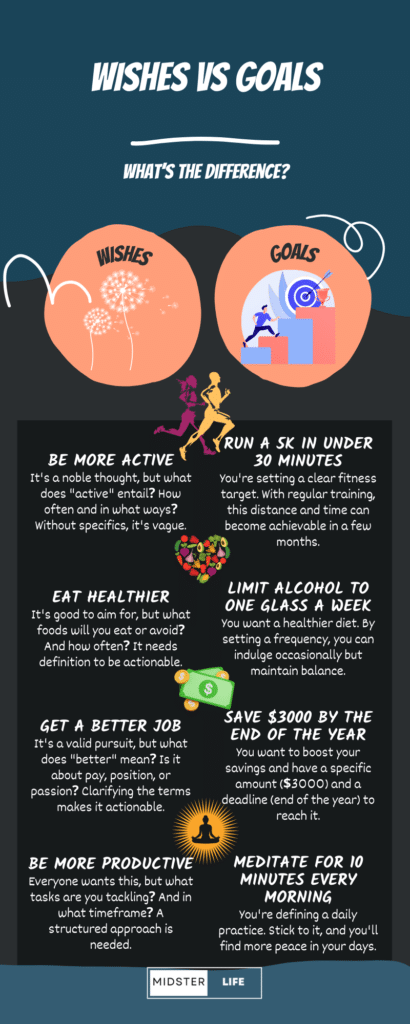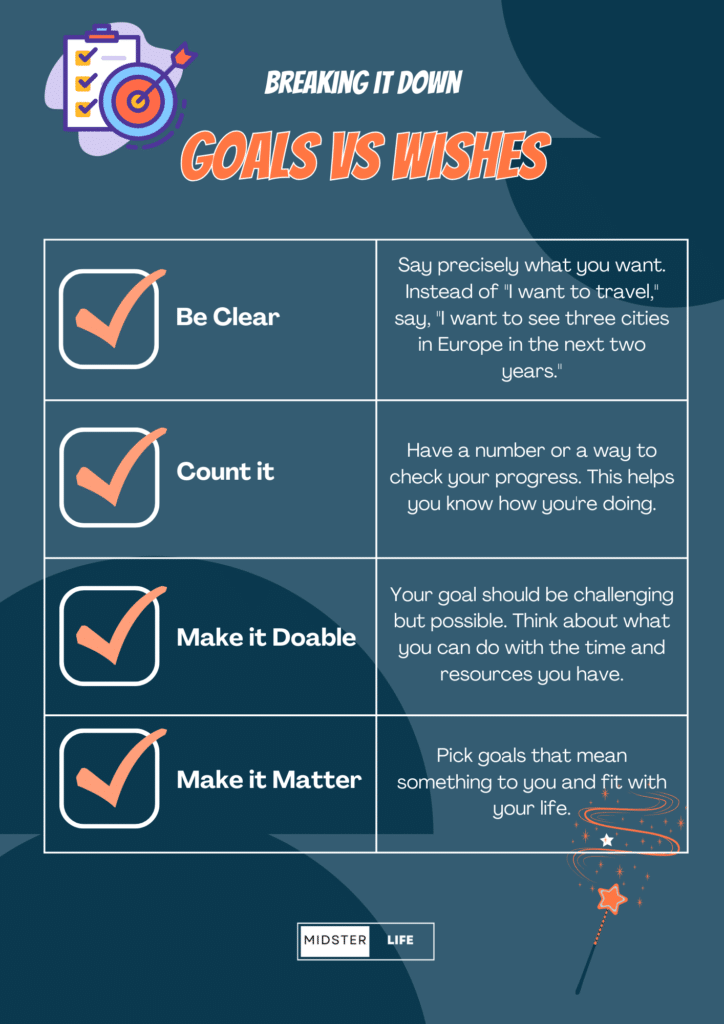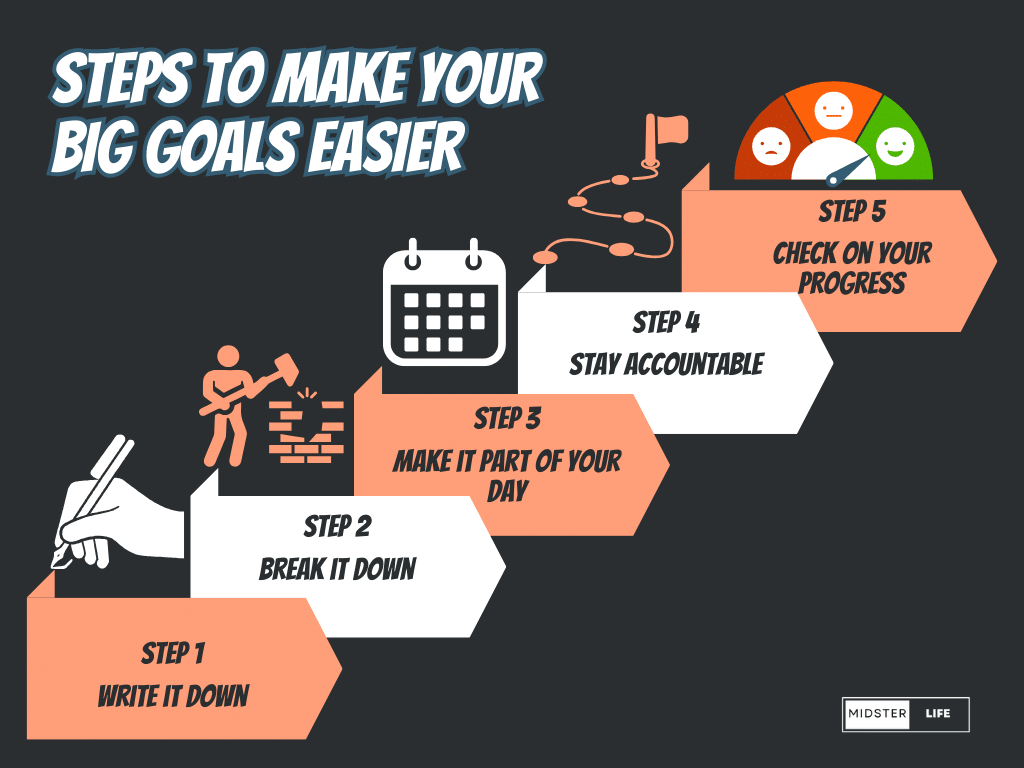Goal Setting After 40: Empower Your Future
- Goal Setting After 40: Empower Your Future
- Why Goal Setting After 40 is Good
- Goals vs. Dreams: What's the Difference?
- Understanding SMART Goals (And How To Use Them)
- Understanding ABC Goals
- Goal Setting After 40: Examples
- Picking Goals That Are Just Right
- Making a Plan to Reach Your Dreams
- Let's Get Started: Time to Shape Your Goals!
- Frequently Asked Questions
Turning 40 can be the start of a new adventure. It’s a great time to think about what you want in life. It may also be a time when you face significant challenges and feel unbalanced across some areas of your life. No matter how old you are, goal setting after 40 can help you grow, find your purpose, and do amazing things. If the future excites you, you are far more likely to get the most out of this pivotal period.
And if goal setting has felt challenging before, know that things can change. You’re not on this journey alone. We’re here to guide you and help you improve your goal-setting skills. So, let’s get going and transform your post-40 dreams into reality.
Why Goal Setting After 40 is Good
Having goals is like having a map for your life, especially when you’re over 40. When you set goals, you pick the things you want to improve. Maybe you want to lose weight, get healthier, make friends, or learn new things at work. When you work on these goals, you feel proud and happy.
The Benefits of Goal Setting After 40

Having goals does more than help you grow. It also:
- Provides you with a clear path to follow.
- Keeps you motivated and makes you want to keep going, even when it’s tough.
- Helps you bounce back when things go wrong.
- Helps you be more productive and make the most of your time.
When you have clear goals, you know where you want to go. This makes it easier to choose what to do next. It also keeps you excited and helps you keep going, even when things get hard. Plus, when you face problems and get through them, you become stronger and more prepared for the next challenge.
The Difference Between Floating and Steering Your Life

Without goals, life can feel like you’re floating, going wherever the wind takes you. But by setting goals after 40, you become the captain of your ship, choosing where to go. Having goals lets you pick your path and what’s important to you.
It doesn’t matter if you’re over 40 or younger; setting goals is always a good idea. By choosing your dreams and working on them, you’ll feel more excited, happy, and ready for whatever comes next. So, decide what you want, make it your goal, and watch how you grow and do great things.
Goals vs. Dreams: What’s the Difference?

Understanding Goals and Dreams
When we talk about goals, knowing how they differ from dreams is vital. Think of goals as the precise steps you want to take and dreams as the things you hope for without a solid plan.
For instance, saying, “I hope I get healthy,” is just a dream. But saying, “I’ll work out for 30 minutes five times a week,” is a goal. With goals, you know exactly what you’re doing and can see if you’re getting there.
Why Just Dreaming Doesn’t Always Work
As you get older, you learn that having dreams isn’t enough. You may have had more time to figure things out when you were younger. But now, you want to make the most of your time. Dreaming can leave you feeling lost and upset because there’s no plan to follow.
Why Clear Goals Make a Difference
When you have clear goals, you guide yourself on where to go. For example, if you want to save money, you can save a certain amount every month. This way, you know exactly what to do next.
In short, effective goal setting after 40 enables you to:
- Focus on what’s important.
- See how well you’re doing.
- Change your plan if needed.
With this method, you can reach your dreams and be proud of your achievements.
Understanding SMART Goals (And How To Use Them)

Goals act as our personal maps, showing us where we want to go. And for people around 40, having SMART goals makes the journey easier. Let’s learn what SMART goals are and how to use them.
What Does SMART Stand For?
SMART is an easy way to remember how to set good goals. Here’s what each letter means:
- Specific: Make your goal clear and easy to understand. Ask yourself who, what, where, when, and why.
- Measurable: Figure out how you’ll know you’re getting closer to your goal. It could be losing a certain amount of weight or saving a certain amount of money.
- Achievable: Your goal should be something you can reach. It’s good to dream big, but make sure you can do it.
- Relevant: Your goal should matter to you and fit with your bigger dreams.
- Time-Bound: Set a time when you want to achieve your goal. This will help you stay focused.
Understanding ABC Goals

We can think of our goals in three ways, like the ABCs: Achievable, Big, and Challenging.
Let’s break down what each one means and why they’re essential.
A for Achievable Goals
Achievable goals are things you know you can do soon. They’re important because:
- They keep you motivated since you can reach them.
- They lower stress because they’re doable.
- You feel great when you achieve them, pushing you to do more.
- They help you get closer to your bigger dreams.
B for Big Goals
Big goals are your big dreams for the future. They’re important because:
- They give you direction and remind you of your bigger purpose.
- They keep you inspired, even when things get hard.
- They push you to think creatively.
- They help you grow and learn over time.
C for Challenging Goals
Challenging goals aren’t easy; they push you to do more than you thought possible. They’re important because:
- They make you tougher and help you bounce back from setbacks.
- They help you learn and grow faster.
- You’ll feel amazing when you achieve them.
- They help you break past doubts you might have about yourself.
By using the ABCs of goals, you’ll have a mix of short-term wins, big dreams, and challenges that push you. Keep a smile on your face, and remember, every step gets you closer to where you want to be!
Goal Setting After 40: Examples

When you set goals after turning 40, ensure they’re clear and something you can work towards. Here’s a look at some good goals:
- Lose 15 pounds in three months: You want to drop weight and have a set amount (15 pounds) and a set time (three months) to do it. If you eat right and exercise, it’s a doable goal.
- Read a book every month: This goal tells you precisely what to do. By the end of each month, you should have finished one book.
- Help out twice a month at a nearby community center: This goal means you plan to volunteer two times every month.
Things That Aren’t Goals
Some things sound like goals but are more like wishes because they’re too broad. Here are some examples:
- Be happier: It’s great to want this, but what does “happier” mean? How can you know when you’ve reached it?
- Become rich: This wish doesn’t tell you how much money you want or by when. Plus, it doesn’t say how you’ll do it.
- Travel more: It sounds fun, but where do you want to go? How often? For how long? Those details are necessary for it to be a wish rather than a goal.
Breaking It Down: Goals vs. Wishes

When thinking about goals, you want them to be clear. Here’s how to tell the difference between a tangible goal and just a wish:
- Be clear: Say precisely what you want. Instead of “I want to travel,” you can say, “I want to see three cities in Europe in the next two years.”
- Count it: Have a number or a way to check your progress. This helps you know how you’re doing.
- Make it doable: Your goal should be challenging but possible. Think about what you can do with the time and resources you have.
- Make it matter: Pick goals that mean something to you and fit with your life.
Picking Goals That Are Just Right

The “Goldilocks Rule”: Not Super Hard, But Not Super Easy
Goal setting after 40 can be fun but tricky. You want to find goals right in the middle – not super hard, but not too easy. It’s like when Goldilocks wanted her porridge “just right.” Your goals should need some effort but also be something you can achieve.
Think about:
- What can you do now?
- What tools do you have?
- And how much time have you got?
Be honest about what you’re good at and where you need help.
Why Picking Something You Love Matters
When you really like doing something, it’s called “intrinsic motivation.” It means you’re doing it because it makes you happy, not because someone else wants you to or you’ll get a prize. You’ll put in the work when you care about your goal, even if it gets tough.
Think about:
- What makes you happy?
- What’s important to you?
Pick goals that match those things. That way, you’ll stick with them and have a better chance of making them happen.
Changing Your Goals to Keep Going Strong
If you’re working on a goal and it feels too easy or way too hard, it’s okay to change it. Goals should be something you can do with effort but are not impossible.
Now and then, review your goals:
- Have you learned anything new?
- Has anything in your life changed?
- Have you found a better way to do something?
If you need to, change your goal so it’s just the right amount of hard.
By checking and changing your goals, you’ll stay excited about them and keep moving forward.
Making a Plan to Reach Your Dreams

Why Plans and Habits Matter More than Goals Alone
If you’re over 40 and setting goals, it’s wise to think about the steps or habits that’ll get you there. You can set up routines that help you move towards your dreams every day. Making good habits can help you stick with it and get things done!
Steps to Make Your Big Goals Easier

- Write It Down: Documenting your goal helps cement your commitment to it.
- Break It Down: Think of your goal as a big puzzle. Now, break it into smaller pieces or tasks. For example, if you want to get in shape, your pieces might be “work out for 30 minutes” and “eat healthier snacks.” This way, you can tackle one piece at a time.
- Make It Part of Your Day: Take time to work on your goals. This might mean setting aside time every morning or evening. It’s easier to keep going when it becomes a regular part of your day.
- Stay Accountable: This can involve having an accountability partner, setting up regular check-ins, or using tools and apps that help monitor progress. Feedback from yourself and others can help you adjust your approach if necessary.
- Check On Your Progress: Seeing how much you’ve done is fun! You could use apps, a diary, or a checklist. This also helps you see if you need to change something.
Let’s Get Started: Time to Shape Your Goals!

So, you’ve learned a lot from our empowering guide on goal setting after 40. What’s next? Time to jump in! Use what you’ve learned here to make your goals sharper and more doable. Reaching a big dream is easier when you break it into smaller steps.
It’s a good idea to get some cheerleaders on your side. Share your goals with friends or family who will support and encourage you. You could join a group with similar goals or find a coach to guide you. Having a team behind you can make a big difference.
So, take this step in your goal-setting journey. In doing so, you’ll not only make impactful decisions for your future but also pave the way for a richer and more fulfilling life.
Frequently Asked Questions
Why Can Goal Setting Change My Life?
Using these tips and tricks, you’re not just setting goals – you’re changing your life! You’ll find that you’ll feel happier and more fulfilled as you move towards your goals. And remember, life can be unpredictable if you need to change your goals to fit new situations. Just keep going, and don’t give up!
Why should I set goals at this stage in my life?
Goal setting is for more than just the young. When you’re over 40, it helps you keep growing, stay motivated, and give you a clear purpose. Plus, it’s great for your mind and emotions, strengthening you when facing tough times. And if you’re looking to climb up the career ladder or learn new things, goals are your roadmap.
It’s also important to note that in your 50s, you may experience mindset changes. By taking the time to work on your goals and mindset in your 40s, you can position yourself to better deal with the challenges of your 50s.
Can you give me some goal ideas that fit my age group?
Absolutely! Here’s what others over 40 often aim for:
- Moving up in their job or trying a new career.
- Hitting money targets, like clearing debts or saving up for big moments.
- Learning new things or getting a degree.
- Getting fit in ways that suit their age and body.
- Making their bonds stronger, like quality family time or making new friends.
Why is setting goals a big deal for my age group?
There are loads of reasons:
- Knowing Yourself Better: Goals help you see what you’re good at and what you care about.
- Feeling Great: You feel proud and sure of yourself when you hit your goals.
- Staying on Track: Goals keep your eyes on the prize so you stay focused.
- Being Ready for Anything: With short- and long-term goals, you can tackle whatever comes your way.
- Staying Healthy and Happy: Setting health and mental well-being goals means a brighter, active future.


